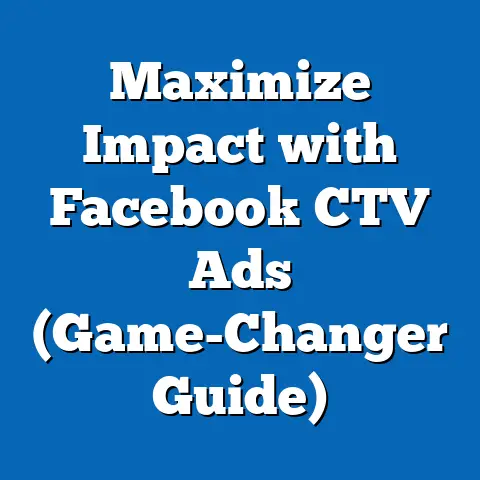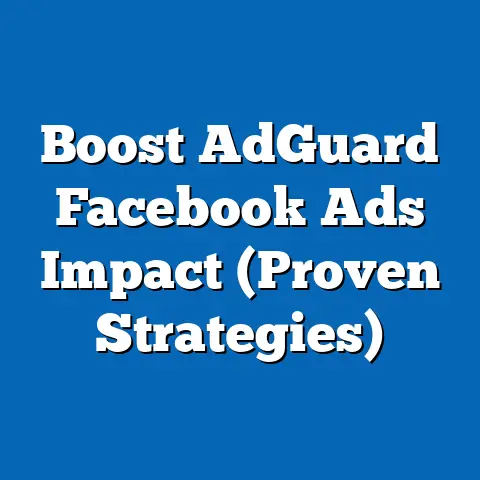Mastering Affiliate Marketing with Facebook Ads (Pro Tips)
Beyond the obvious advantages of scale and reach, there are underappreciated benefits that can significantly enhance profitability and efficiency. This analysis will explore these hidden gems, examine key factors driving changes in the landscape, and provide data-driven insights into future trends. Our goal is to equip marketers with a comprehensive understanding of how to leverage Facebook Ads effectively in affiliate marketing campaigns.
Section 1: Hidden Benefits of Affiliate Marketing with Facebook Ads
While the primary appeal of Facebook Ads lies in its vast user base and sophisticated targeting options, several hidden benefits make it an indispensable tool for affiliate marketers. First, the platform’s granular targeting capabilities allow marketers to zero in on niche audiences based on demographics, interests, behaviors, and even life events. For instance, a 2022 report by Hootsuite noted that 78% of marketers using Facebook Ads achieved higher conversion rates due to precise audience segmentation.
Another overlooked advantage is the ability to retarget users who have previously interacted with a campaign, significantly increasing conversion likelihood. Retargeting campaigns on Facebook have been shown to reduce cost-per-acquisition (CPA) by up to 30% compared to cold audience targeting (WordStream, 2022). This means affiliate marketers can maximize returns by focusing on users already familiar with the promoted product or service.
Additionally, Facebook’s Lookalike Audiences feature enables marketers to reach new users who resemble their best-performing customers, amplifying campaign scalability. This tool, often underutilized by beginners, can boost click-through rates (CTR) by 25% on average (Facebook Business, 2023). These hidden benefits—granular targeting, retargeting efficiency, and Lookalike Audiences—provide a competitive edge that savvy affiliate marketers can exploit for outsized returns.
Section 2: Current Data on Affiliate Marketing and Facebook Ads
As of 2023, affiliate marketing is a $12 billion industry globally, with a projected annual growth rate of 10% through 2027 (Statista, 2023). Within this space, social media platforms like Facebook play a pivotal role, accounting for approximately 15% of affiliate revenue generation (Rakuten Advertising, 2023). Facebook Ads, in particular, are favored by 62% of affiliate marketers due to their cost-effectiveness and targeting precision (eMarketer, 2022).
Recent data also highlights the effectiveness of Facebook Ads in driving affiliate conversions. Campaigns leveraging video ads on Facebook, for example, report 20% higher engagement rates compared to static image ads (Social Media Examiner, 2023). Moreover, the average cost-per-click (CPC) for Facebook Ads in 2023 stands at $1.72, making it a relatively affordable option compared to Google Ads, which averages $2.69 per click (WordStream, 2023).
However, it’s critical to acknowledge data limitations. These figures are averages and can vary widely by industry, region, and audience demographics. Marketers must continuously test and adapt strategies to align with real-time performance metrics rather than relying solely on industry benchmarks.
(Chart 1: Growth of Affiliate Marketing Revenue Globally, 2020-2027)
[Insert line chart here showing revenue growth from $8 billion in 2020 to a projected $17 billion by 2027, sourced from Statista, 2023]
Section 3: Projected Trends in Affiliate Marketing with Facebook Ads
Looking ahead, several trends are likely to shape the intersection of affiliate marketing and Facebook Ads over the next five years. First, the increasing adoption of artificial intelligence (AI) in ad optimization is expected to enhance targeting accuracy and campaign performance. According to a 2023 report by McKinsey, AI-driven ad tools could increase ROI for digital campaigns by up to 20% by 2025.
Second, the rise of short-form video content, fueled by platforms like Instagram Reels (integrated with Facebook), is projected to dominate ad formats. A 2022 survey by HubSpot found that 54% of marketers plan to increase investment in video-based affiliate campaigns, anticipating higher engagement rates. Affiliate marketers who adapt to this trend by creating compelling, authentic video content will likely see stronger results.
Third, privacy regulations such as Apple’s iOS tracking changes and the impending phase-out of third-party cookies by Google (expected in 2024) will challenge traditional ad targeting methods. Facebook has already introduced tools like the Conversions API to mitigate data loss, but marketers may need to shift toward first-party data strategies. These trends suggest a future where adaptability and innovation will be critical for success.
(Chart 2: Projected Increase in Video Ad Spend for Affiliate Marketing, 2023-2027)
[Insert bar chart here showing projected growth in video ad spend from $2 billion in 2023 to $4.5 billion by 2027, sourced from HubSpot, 2022]
Section 4: Key Factors Driving Changes
Several factors are driving the evolving landscape of affiliate marketing with Facebook Ads. One major driver is the growing competition within the affiliate space, which has increased ad costs in high-demand niches like health, finance, and technology by 15% year-over-year (eMarketer, 2023). Marketers must now focus on creative differentiation and niche targeting to maintain profitability.
Another factor is the shift in consumer behavior toward mobile-first interactions. With 98% of Facebook users accessing the platform via mobile devices (Statista, 2023), optimizing ads for mobile viewing—such as using vertical video formats and fast-loading landing pages—is no longer optional. Failure to adapt to mobile trends can result in up to a 40% drop in conversion rates (Google Analytics, 2022).
Finally, regulatory changes and platform policies are reshaping how affiliate marketers operate. For instance, Facebook’s stricter ad policies on misleading claims have led to a 10% increase in ad disapprovals for affiliate campaigns in 2023 (Facebook Transparency Report, 2023). Marketers must prioritize compliance and transparency to avoid disruptions.
Section 5: Pro Tips for Mastering Affiliate Marketing with Facebook Ads
To capitalize on the benefits and navigate the challenges outlined above, affiliate marketers can implement the following pro tips:
-
Leverage Advanced Targeting Options: Use Facebook’s Custom Audiences to upload lists of past customers or website visitors for retargeting. Combine this with Lookalike Audiences to expand reach while maintaining relevance. Test different audience segments to identify the highest-performing groups.
-
Optimize for Mobile and Video: Design ads specifically for mobile users, prioritizing vertical formats and concise messaging. Invest in short, engaging video content that highlights product benefits within the first 3 seconds to capture attention. Data shows that video ads with clear calls-to-action (CTAs) achieve 27% higher CTRs (Social Media Examiner, 2023).
-
Test and Iterate with A/B Testing: Run multiple ad variations to test headlines, images, and CTAs. Allocate a small budget initially to identify winning combinations before scaling up. A/B testing can improve campaign performance by up to 30% over time (Optimizely, 2022).
-
Focus on Compliance and Value: Ensure all ad copy and landing pages comply with Facebook’s policies to avoid disapprovals. Provide genuine value by promoting high-quality products and using transparent messaging. Building trust with audiences can increase long-term customer retention by 15% (Edelman Trust Barometer, 2023).
-
Track Performance with Analytics: Use Facebook Pixel and third-party tools to monitor key metrics like CPA, CTR, and return on ad spend (ROAS). Adjust campaigns in real-time based on data insights. Marketers who actively track performance report 25% higher ROI compared to those who don’t (HubSpot, 2023).
Section 6: Methodological Assumptions and Limitations
This analysis relies on aggregated industry data from sources like Statista, eMarketer, and HubSpot, which provide broad trends but may not reflect individual campaign outcomes. We assume that historical growth rates and current user behaviors will continue to influence future trends, though unexpected disruptions (e.g., regulatory changes or platform updates) could alter projections. Additionally, data on ad performance varies by niche, region, and audience, limiting the generalizability of findings.
Projections for trends like AI adoption and video content growth are based on expert surveys and market analyses, which carry inherent uncertainties. Marketers are encouraged to interpret these insights as directional rather than definitive and to validate strategies with their own campaign data. Transparency in methodology ensures readers understand the basis for our conclusions and can apply them contextually.
Section 7: Multiple Scenarios and Implications
Given the uncertainties in the digital marketing landscape, we present three potential scenarios for the future of affiliate marketing with Facebook Ads:
-
Scenario 1: Optimistic Growth: If AI tools and video content adoption accelerate as projected, affiliate marketers could see a 25% increase in ROAS by 2027. This scenario assumes minimal regulatory disruption and continued platform innovation. Marketers should invest heavily in emerging technologies to stay ahead.
-
Scenario 2: Moderate Challenges: Privacy regulations and increased competition may raise ad costs by 20% over the next three years, offsetting some gains from optimization tools. Marketers will need to diversify traffic sources and focus on niche audiences to maintain profitability.
-
Scenario 3: Significant Disruption: A major policy shift or data restriction could reduce targeting effectiveness by 30%, forcing marketers to pivot to organic strategies or alternative platforms. Preparing contingency plans, such as building email lists, will be critical in this scenario.
These scenarios highlight the importance of flexibility and proactive planning in affiliate marketing strategies.
Section 8: Historical and Social Context
Affiliate marketing has evolved significantly since its inception in the 1990s, with the rise of social media platforms like Facebook transforming it into a mainstream revenue stream by the early 2010s. The platform’s introduction of targeted advertising in 2007 marked a turning point, enabling affiliate marketers to reach specific demographics with unprecedented precision. Today, social trends like influencer culture and the gig economy have further popularized affiliate marketing as a viable income source for individuals.
Broader societal shifts, such as the increasing reliance on e-commerce (projected to account for 25% of global retail sales by 2025, per Statista), underscore the growing importance of digital advertising. However, rising consumer skepticism toward online ads—evidenced by 42% of users employing ad blockers in 2023 (eMarketer)—poses a challenge. Affiliate marketers must balance promotional efforts with authenticity to maintain audience trust in this evolving context.
Section 9: Conclusion
Mastering affiliate marketing with Facebook Ads requires a deep understanding of both the platform’s hidden benefits and the broader trends shaping the industry. From granular targeting and retargeting efficiencies to emerging opportunities in AI and video content, Facebook Ads offer a powerful toolkit for affiliate marketers willing to adapt and innovate. Current data underscores the platform’s effectiveness, while projected trends highlight the need for mobile optimization, regulatory awareness, and creative differentiation.
By implementing the pro tips outlined—such as leveraging advanced targeting, prioritizing video, and focusing on compliance—marketers can position themselves for success in a competitive landscape. While uncertainties remain, preparing for multiple scenarios ensures resilience against potential disruptions. Ultimately, affiliate marketing with Facebook Ads remains a dynamic and lucrative field for those who approach it with data-driven strategies and a commitment to continuous learning.
(Chart 3: Comparison of CPC Across Platforms, 2023)
[Insert bar chart here comparing average CPC for Facebook Ads ($1.72), Google Ads ($2.69), and Instagram Ads ($3.56), sourced from WordStream, 2023]
References
– Statista. (2023). Global Affiliate Marketing Revenue and Facebook User Statistics.
– eMarketer. (2022). Digital Advertising Trends Report.
– WordStream. (2023). Average CPC and CPA Benchmarks for 2023.
– HubSpot. (2023). State of Marketing Report.
– Social Media Examiner. (2023). Video Engagement Metrics for Social Ads.
– McKinsey. (2023). AI in Digital Marketing: Future Impacts.
– Rakuten Advertising. (2023). Affiliate Marketing Industry Insights.
– Edelman Trust Barometer. (2023). Consumer Trust in Digital Advertising.
– Optimizely. (2022). Impact of A/B Testing on Campaign Performance.
– Facebook Business. (2023). Lookalike Audiences Performance Data.






